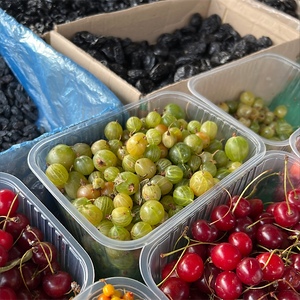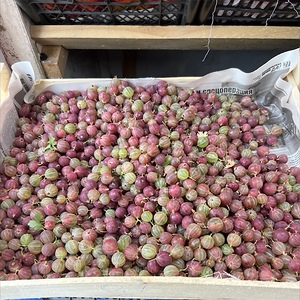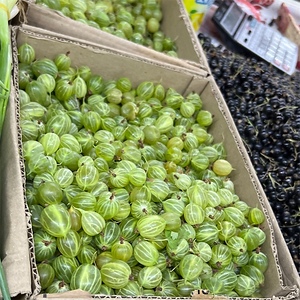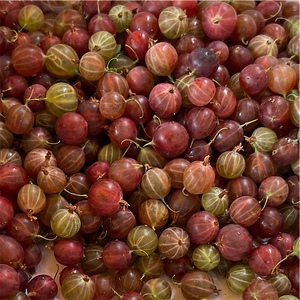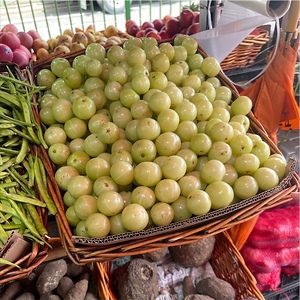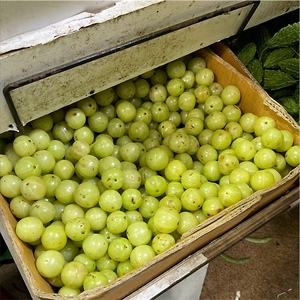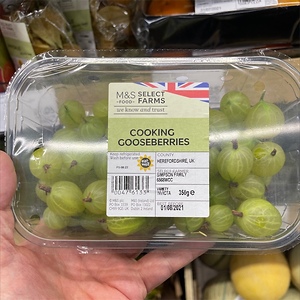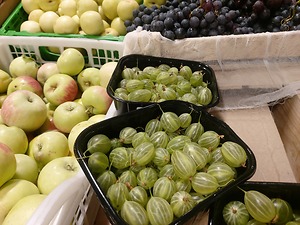


Green Gooseberries
Estimated Inventory, 12 ct : 0
Description/Taste
The Green gooseberry is a widely varied fruit depending upon the cultivar. The exterior can range in texture from smooth and translucent to fuzzy and opaque. They can vary in size from that of a large cherry tomato to smaller than a blueberry. The round or slightly oblong berries have a taut, pale green skin and tomato-like flesh dotted with tiny edible seeds. Their tart juicy flesh is not as sweet as the red varieties, but offers flavors of kiwi, starfruit and green grape with a moderately acidic floral finish.
Seasons/Availability
Green gooseberries are available in the summer.
Current Facts
Gooseberry is an umbrella term for almost 2,000 different cultivars within the Ribes genus. There are two main types, American (Ribes hirtellum) and European (R. uva-crispa or R. grossularia). The European variety is far superior in flavor, size and texture and the classic berry for most culinary uses. The 'Invicta' gooseberry is one of the most commonly grown green European cultivars. A completely unrelated fruit named the Cape gooseberry (Physalis peruviana), is actually a closer relative to the tomatillo and a member of the Solanaceae family.
Nutritional Value
Green gooseberries provide twenty times more vitamin C than an orange. They are also rich in vitamins A, B1, B5 and B6, folate, calcium, magnesium, potassium and copper.
Applications
Fresh Green gooseberry's sweet-tart flavor can be used in both sweet and savory dishes, whether cooked, raw, mashed, pureed, preserved, even pickled. Stud a sweet almond tart with the sour, gem-like green berries to add little bursts of natural acidity. The berries make an excellent jam or syrup for beverages and cocktails. Cook the Green gooseberries down into a chutney spiked with clove, star anise and black pepper to accompany fresh goat cheese spread on toast. Slice the Green gooseberries in half and submerge in a saltwater brine and pickling spices for a relish to pair with sausages, pork, lamb or grilled fish. Complimentary ingredients include pistachios, pine nuts, almonds, bramble berries, stone fruit, aged balsamic vinegar, salad greens such as butter lettuce and arugula, apples, fresh and dried figs, fennel, bacon and basil.
Ethnic/Cultural Info
Gooseberries have a rich history steeped in traditional British recipes and horticulture. A favorite dessert since the Tudors controlled the throne, known as a gooseberry fool, consists of folding sweetened Green gooseberry jam into freshly whipped cream. Competitive gooseberry growing was a popular pastime up to World War I, when there were 170 shows in Northern England. The Egton Bridge Old Gooseberry Society, established in 1800, is the oldest surviving show in the country.
Geography/History
Gooseberries are native to the European Caucasus Mountains and North Africa, even the so-called American cultivars have genetics that can be traced back to the earliest European varieties. The British can be credited for their work in the sixteenth century in developing many of the varieties we see today. Gooseberries grow best in humid summer conditions and are extremely cold-hardy, and can be found growing as far north as the Arctic Circle.
Recipe Ideas
Recipes that include Green Gooseberries. One



